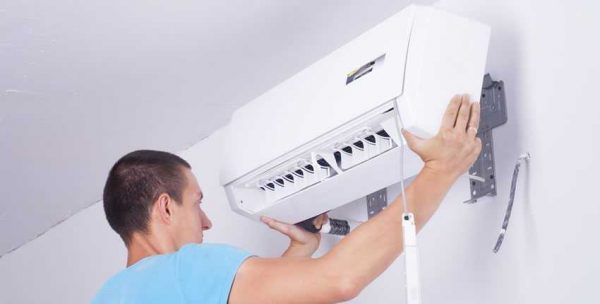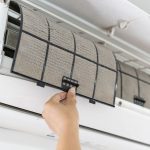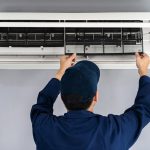Tips For Maintaining And Cleaning Your Air Conditioner In a Tearoom Setting
Before you are able to deep-clean your air conditioner, there are a few initial cleanings and checks that need to be done. This pre-cleaning checklist is essential in order to ensure that the air conditioner is running properly and safely.
In this section, we will go over the pre-cleaning checks that need to be done in order to maintain a clean and healthy atmosphere in your tearoom:
Inspect the air filter
Prior to any cleaning or maintenance, it is important to thoroughly inspect and clean the air filter. This should be performed every 1-3 months or as recommended by the manufacturer. An unclean filter can reduce your unit’s airflow and performance. Inspect both the inside filter and the outer filter for dirt accumulation. If either is visibly soiled, replace them with new filters of the same size and shape.
To remove an old air filter:
- Turn off your air conditioner at the breaker box
- Open your unit’s access panel to expose the air filter
- Remove the old air filter from its casing
- Inspect for dirtiness, dust or debris
- Clean or replace as needed
- Close access panel and turn on breaker when done
Check the air ducts
Before cleaning or maintaining your air conditioner, you need to inspect the air ducts. If there is any dust and debris build up in the air ducts, you should clean them before doing any further maintenance and cleaning on your unit. This will reduce the risk of dust and dirt being spread throughout the tearoom when the fan is turned on.
The first step is to assess the length of time since last serviced, what type of filter was used and if it needs to be changed.
- If necessary, you should remove any bags or covers from individual parts of the system such as fans and coils then remove any visible debris build-up on these surfaces with a vacuum cleaner; taking care not to damage delicate parts in the process.
- It’s important to check that none of these areas have become blocked which can happen if a large item gets lodged in them or if they are not cleared regularly; this could restrict airflow through your system and can potentially damage certain parts over time from overheating.
- Once these sections have been checked it is then advisable to check for Leakage at fittings and seals, replacing components where necessary for safety considerations.
Check the air conditioner’s settings
Before you start to clean or carry out any maintenance on your air conditioner it’s important to check that the settings are all correct. Carefully adjust the temperature to match the current ambient temperature, and then make sure that the timer is correctly set to switch off at a suitable time. If you haven’t yet used the air conditioner, you should also take a look at any filters located inside the unit, as these may need cleaning before you begin using it.
The most important setting is to ensure that the fan speed is set correctly for your requirements. On most models this will be either low, medium or high, but there may also be additional settings in between these. Generally speaking, higher fan speeds are more effective at quickly cooling a room while lower fan speed quieter and can save considerable energy costs over time. Choosing the correct setting can help save money as well as provide a comfortable environment for customers in your tearoom.
You should also:
- Check if there are regular “service” reminders indicated for your model;
- If so, reset them accordingly once all checks have been made.
Cleaning the Air Conditioner
Cleaning and maintaining your air conditioner is an essential part of keeping your tearoom working efficiently. A dirty air conditioner can cause it to run inefficiently, wasting energy and money.
In this article, we’ll go over tips on how to best clean and maintain your air conditioner in a tearoom setting. We’ll cover everything from cleaning the filter, to changing the fan belt, to inspecting the condenser coils. Let’s dive in!
Vacuum the air filter
To keep your air conditioner operating at peak efficiency and provide the best air quality for your guests, it’s important to vacuum the air filter every two weeks or longer depending on the amount of dirt and dust accumulated in the filter.
- First, shut off power to your unit.
- Then, carefully remove and inspect the filter, discarding any broken or deteriorating material.
- Vacuum both sides of the filter with a soft brush attachment on your vacuum cleaner, then reinstall it after thoroughly washing it with warm soapy water.
- Allow filters to dry completely before reinstalling.
- Additionally, inspect all of the components including coils and electrical wiring and clean away any visible dirt or debris building up around the unit’s outside surface using a damp cloth.
Clean the air ducts
Cleaning the air ducts of your air conditioner is an important part of caring for the appliance and maintaining good air quality in your home. Air ducts trap airborne particles, like dust and debris from pet dander, smoke particles, building construction and renovations, insect droppings, and other contaminants – all of which can eventually flow back into the living space if not cleaned regularly. With regular maintenance to clean the air ducts with appropriate products, you can expect better indoor air quality and improved overall performance of your AC unit.
When cleaning air ducts, it is important to choose a product that is specifically approved for use on HVAC systems. Specially formulated sprays or foams are often sprayed into the vents to help dislodge dirt and other small particles that may be stuck to interior surfaces. After allowing time for the product to work its magic, it should be removed with a vacuum cleaner specifically rated for HVAC systems.
- If you choose a cleaner that contains chlorine or ammonia, ensure that it is well ventilated before doing any kind of cleanup as these substances can cause serious health issues when inhaled in large amounts.
- Finally, once all debris has been removed from the vents and all of the spray residue has dried off surfaces; be sure to reinstall all access panels in order to keep out future dust buildup from entering your living space.
Clean the air conditioner’s evaporator coils
Cleaning the air conditioner’s evaporator coils is important in order to maintain optimal performance and prevent energy losses. Evaporator coils are exposed to dirt, dust and other debris while the air conditioner is running, so they can become clogged with dirt, dust and mildew over time.
To keep these coils clean:
- Make sure that the area around the unit is always clean and clear of debris.
- Check the evaporator coils regularly for any buildup of dust or dirt.
- Clean the coil using a soft brush or vacuum cleaner to remove any dirt or buildup.
- Rinse the coil with warm water and mild detergent when necessary to help remove stubborn dirt.
- Check for any bent fins which can significantly reduce airflow across the coil and reduce efficiency.
- Repair any bent fins with a fin comb tool before replacing them on their mounting points on the coil’s housing.
Maintaining the Air Conditioner
Maintaining an air conditioner in a tearoom setting is essential for providing a comfortable environment for guests. Regular maintenance and cleaning of the air conditioner helps ensure it is operating efficiently and effectively, while also helping to extend its lifespan.
In this section, we will cover the various tips for maintaining and cleaning the air conditioner in a tearoom setting:
Change the air filter regularly
Regular air filter changes are a critical part of maintaining any air conditioner, especially in commercial environments. This is because tearooms tend to accumulate dust and other particles much more quickly than normal residential dwellings. The air filter should be changed every three to four weeks, or more often if it becomes clogged.
Not only will a clogged filter make the tearoom environment uncomfortable and unhygienic for guests, regular cleaning allows the machinery to function optimally. A clean filter keeps your utility costs down by promoting efficient airflow, as well as helping your air conditioner last longer overall.
One of the most important factors to keep in mind when changing an air filter is the type used for your specific system and its size. Improperly fitting filters can reduce efficiency and cause damage to your system over time. If you experience an unexpected decrease in efficiency or poor air quality after replacing a filter, double check that it’s the correct size for your unit before trying something else. Additionally, if you have carpeted areas in your tearoom space then consider using a HEPA (high-efficiency particulate air) filter.
By following these tips and taking appropriate steps to maintain their Air Conditioners on a regular basis, owners of tearooms can look forward to enjoying clean and energy-efficient Air Conditioners throughout the hot summer season!
Check the air ducts for blockages
The air ducts of your air conditioner are responsible for controlling the conditioned air and are an important part of its cooling effect. It is essential to check the ducts and make sure that no material is blocking the airflow. Blockages in the air ducts can result in inadequate cooling, higher electricity bills and excess noise. In some cases, blockages can even reduce indoor air quality by trapping bacteria and other contaminants within the system.
To avoid such problems, it is recommended to inspect your system at least once a year and clear any blockages from the air ducts. The exact process may vary depending on your unit’s model but be sure to check any filters you have installed for dirt or clogs as this may help to improve performance as well.
To insure that all components of your system are working properly, contact a licensed HVAC technician who can perform a full inspection and provide maintenance when needed.
Check the air conditioner’s settings
It is important to check the air conditioner’s settings regularly and adjust as needed. The temperature setting should be adjusted so that the room remains comfortable and at a consistent temperature. A thermostat will help maintain the temperature level and ensure the air conditioner is running efficiently.
Additionally, it is important to periodically check that all air vents are open, unobstructed, and clean of dust or debris to ensure optimal functioning.
Regularly changing the filter can also help keep your air conditioning unit running efficiently. Depending on use levels, filters should be replaced every one to three months for optimum performance. During particularly hot weather, you may need to replace them more frequently than you normally would as dirt and dust can accumulate quickly in a tearoom setting. Make sure to follow your manufacturer’s recommendations for selecting a replacement filter that meets your specific needs.
Finally, keeping furniture away from the air vents will help optimize airflow from your AC unit and minimize energy consumption from improper adjustment of settings such as fan speed or reversing valves which cause drafts when not set correctly.
Troubleshooting
Troubleshooting is an important step when it comes to maintaining and cleaning your air conditioner in a tearoom setting. There are a variety of potential issues that can arise, ranging from a lack of airflow to a clogged filter. By troubleshooting, you can determine the cause of the issue and make the necessary repairs to ensure your air conditioner is running at its best.
Let’s look at some tips for troubleshooting and maintaining your air conditioner:
Check the air filter
Regularly checking the air filter of your heating, ventilation, and air conditioning (HVAC) system is a simple but important step in maintaining efficient performance and preventing potential breakdowns. A clogged or dirty filter will reduce airflow and strain your system, requiring it to work harder than normal to cool your home. To keep it running as efficiently as possible, make sure that you check the air filter every month. If it looks dirty or clogged, replace it with a new one.
It’s also important to use the correct size filter for your unit. Choosing a size that is too small means that particles can get through and get into your furnace or air conditioner blower motors and damage them over time. Using a larger size may limit airflow and cause the system to work harder to cool or heat the home.
Check the air ducts
Maintaining a comfortable temperature in your tearoom requires regular inspections and cleaning of the air ducts. This can help improve airflow and reduce dust and dirt build-up.
- Begin by ensuring the air ducts are free from obstructions and are in good repair, as there may be blockages or loose connections which could hamper efficiency.
- Remove any physical obstructions inside the air ducts and make sure that all filters are secure and clean, replacing them if needed.
- When finished, be sure to reset the unit for it to function properly.
Check the air conditioner’s settings
When you’re having trouble with your air conditioner, the first step is to check its settings. Depending on the type of air conditioner you have, there should be a control panel that houses all the controls for temperature, fan speed, and other settings. Make sure these settings are correct and that nothing is set too high or low. If everything checks out, you may need to clean or replace the air filter.
Air filters are responsible for removing dust and other large particles from circulation in your room as well as preventing small objects from entering into the indoor unit of your air conditioner. A clogged filter will cause a buildup of dirt and debris, which will ultimately reduce airflow from the unit. To clean or replace an air filter, make sure that power to your unit is turned off and then simply remove the filter according to manufacturer instructions and either clean it if it reusable or replace it with a new one if needs be.
If cleaning does not solve your problem, then further inspection is needed by contacting a qualified technician to come inspect the system further looking through all components such as:
- Coils
- Compressors
- Connections




